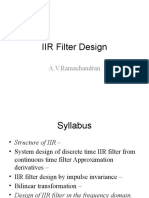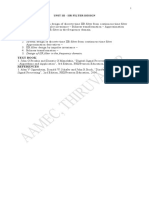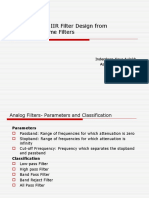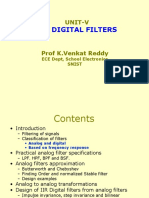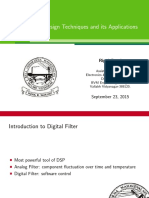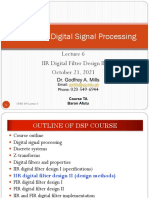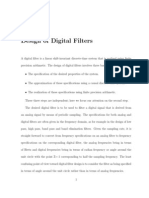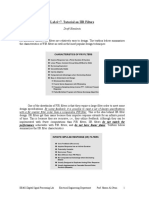0 ratings0% found this document useful (0 votes)
78 views84 pagesECE311 Notes
this is an imp doc
Uploaded by
vishal raiCopyright
© © All Rights Reserved
We take content rights seriously. If you suspect this is your content, claim it here.
Available Formats
Download as PDF or read online on Scribd
0 ratings0% found this document useful (0 votes)
78 views84 pagesECE311 Notes
this is an imp doc
Uploaded by
vishal raiCopyright
© © All Rights Reserved
We take content rights seriously. If you suspect this is your content, claim it here.
Available Formats
Download as PDF or read online on Scribd
You are on page 1/ 84
DESIGN AND ANALYSIS OF INFINITE IMPULSE RESPONSE wry orerra.rutens__\ 455 \
2, Specifications Required
Inany filter design, following specifications are
(i) The maximum tolerable passhy
Gi) The maximum tolerable stoph,
(ii) Passband edge frequency («,)
Gv) Stopband edge frequency ()
required:
andl ripple (6)
rand ripple (6)
7.6 IR FILTER DESIGN FROM CONTINUOUS.TIME FILTERS
As a matter of fact, the commonly used tech
ce ques for the design of HR filters are based on
transformations of continuous-time IIR systems into diserote-time IIR systems, "This is partly because
continuous-time filter design was a highly advanced art before diserote-time filters were of interest
and partly because of the difficulty of implementing a non-iterative direct design method for IIR.
filters. In contrast, FIR filters are almost entirely restricted to discrete-time implementations.
Consequently, the design techniques for FIR filters are based on directly approximating the desired
frequency response of the discrete-time system. Furth rmore, most techniques for approximating
the magnitude response of an FIR system assume a linear phase constraint, thereby avoiding the
problem of spectrum factorization that complicates the direct design of IIR filters. The simplest
method of FIR filter design is called the window method. This method generally begins with an ideal
desired frequency response.
As discussed earlier, in order to design the digital IIR filter,
first analog IIR filter is designed.
Then analog filter is converted into the digital fi
Iter because of following two reasons:
(i) The procedure to design analog filter is readily available and it is highly advanced.
(ii) When we design digital filter using analog filter then the implementation becomes simple.
7.7 IMPULSE INVARIANT TRANSFORMATION: IMPULSE INVARIANT METHOD
]———— Eee
In this method, the design starts from the specifications of analog filter. Here, we have to replace
analog filter by digital filter. This is achieved if impulse response of digital filter resembles the
sampled version of impulse response of analog filter. If impulse response of both, analog and digital
filter matches then, both filters perform in a similar manner.
In this method, we shall use the following different notations:
h,(t) = Impulse response in time domain
H,(s) = Transfer function of analog filter, here ‘s’ is Laplace operator
h,(nT) = Sampled version of h,(t), obtained by replacing t by nT
H(2) = z-transform of h(n). This is response of digital filter.
= Analog frequency
= Digital frequency
7.7.1 Transformation of Analog System Function H,(s) to Digital System Function H(z)
Now, let the system transfer function of analog filter be H,(s). We can express H,(s) in terms of
Partial fraction expansion. This means that:
Therefore, wd 712)
Here, A;= Aj, Ag... Ayy are the coefficients of partial fraction expansion.
DIGITAL SIGNAL PROCESSING
Phy Py «= Py are the poles.
Here, ‘s’ is the Laplace operator. Hence, we can obtain impulse response of analo,
e
from H,(s)by taking inverse Laplace transform of H,(s). Therefore, using standard relate ier, hy
Laplace transform, we obtain invey,
N
hw= YA e™ f
a My}
Now, unit impulse response for discrete structure is obtained by sampling hy(t). This mp. _
that h(n) can be obtained from h,(t) by replacing t by nT in equation (7.13). Mea |
x,
. nin?
Thus. hin) = 2A oe ay
Here, Tis the sampling time.
The system transfer function of digital filter is denoted by H(z)". It is obtained by taking
transform of hin). According to the definition of Z-transform for causal system, we have
H@= Yhm)z*
a0
Substituting equation (7.14) in equation (7.15), we get
H()= x [3 on]
azo Lisl
AT
No
YA; Serat ze
n=O
This is the required transfer function of digital filter.
ti
Thus, comparing equations (7.12) and (7.17), we can say that the transfer function aie
filter is obtained from the transfer function of analog filter by doing the following transform
18
7.7.2 Mapping of Poles |
Equation (7.18) shows how the poles from analog domain are transferred into the digital do
This transformation of poles is called as mapping of poles. BP
eS ee —— ee
F Basically, The art of continucus-Cimo IIR filter design is highly advanced and since useful resul
Ire
he achieved, its advantageous to-use the design procedures already developed foreontnue
filters.
DESIGN AND ANALYSIS OF INFINITE IMPULSE RESPONSE (IIR) DIGITAL FILTERS
‘We know that the poles of analog filters are located at s = p,, Ni ion (7.18), we can
cay thatthe poles of digital filter, H(2) are located at, lad
_- (7.19)
‘This equation eee that the poles of analog filter at s = p, are transformed into the poles of,
digital filter’ atz= e?! T. Thus, the relationship between Laplace (s domain) and z-domain is given by,
z= eT (7.20)
Here, = p,and Tis the sampling time.
Now, s is the Laplace operator and it is expressed as,
s= 0 +jQ wAT21)
Here, = attenuation factor
and = analog frequency
We know that z can be expressed in polar form as under:
z= rele (7.22)
Here, ris magnitude and ‘o’ is the digital frequency.
Substituting equations (7.21) and (7.22) in equation (7.20), we obtain
rel = @f0+i0/T — goT, git 2 AT.23)
Separating real and imaginary parts of equation (7.23), we obtain
reo wlT.24)
and ei = oat
‘Thus, we have = OT (7.25)
Now, we will find the relationship between s-plane and z-plane. Basically, plot in ‘s'-domain
means that o is plotted on X-axis and j is plotted on Y-axis. Also, z-domain representation means
that real z is plotted on X-axis and imaginary z is plotted on Y-axis.
Let us consider equation (7.24), i.e.,
r=eT
we shall discuss the following conditions:
i) Ifo < 0, then r is equal to reciprocal of e raise to some constant. Hence, range of r will be
Otolic,,
o<050 0 then, r is equal to e raise to some constant. That means r > Li.e.,
o>0sr>1
Now, o > 0 indicates R.H.S. of s plane and r > 1 indicates exterior part of unit circle. Thus,
RLS. of s-plane is mapped outside the unit circle.
DIGITAL SIGNAL PROCESSING
Combining all the above conditions, this mapping is shown in figure 7.10.
I(2) jo
Re(2)
Fig. 7.10. Illustration of the mapping z = e°T.
7.7.4 Drawbacks of Impulse Invariance Method*
x
We know that @ is analog frequency and its range is from 7 to -7 While the digit
rz
frequency w varies from ~—r ton. This means that from 7 to ~ 7 ,@maps from —nton. Let
i be any integer. Then, we can write the general range of @ as (i ~ bt to G+) £
However, for this range also, maps from ~ x to x. Hence, mapping from analog frequency
Q to digital frequency w is termed as many-to-one. This mapping is not one-to-one.
(Gi) Analog filters are not band limited so there will be aliasing due to the sampling process.
Because of this aliasing, the frequency response of resulting digital filter will not be identical
to the original frequency response of analog filter.
(iii), The change in the value of sampling time (T) has no effect on the amount of aliasing.
Standard Expressions
Some standard formulae for transformation in impulse invariance method are as under:
~T eosbT] 2
= -aT, Tz) + e28t.
1-2e*" [eosbT]z"! +e
Z
1-2e*" feosbT]z! +e 28",
7.7.6 Design Steps for Impulse Invariance Method
not given, then, we obtain expression of H,(s) from the given specifications.
(ii) If required, we expand H,(s) by using partial fraction expansion (PFE). ;
(iii) Then, we obtain z-transform of each PFE term using impulse invariance transformatio?
equation. :
(iv) We obtain H(z), this is required digital IIR filter.
Te The tradi to the design of discrete-time IIR filters involves:
|
}
t
|
G) In numerical problems, analog frequency transfer function H,(s) is usually be given. Ifitis |
f
Te The nal appro’ ‘Valves the transformation of #
continuous-time filter into a discrete-time filter meeting prescribed specifications. |
DESIGN AND ANALYSIS OF INFINITE IMPULSE RESPONSE (IR) DIGITAL FILTERS.
qal solved Examples
Now, let us consider fow solved examples to illustrate the concept of impulse invariance method.
£7.14 Determine H(z) using impul 1
tin Le pulse Invariance method at 5 Hz sampling frequency from
tT?
2
(s+ 1)(542)
Given analog transfer function is,
Ti(s) =
solution:
ASS (ee tise 2) “id
yet us expand H,(s) using partial fraction expansion, ic
A As
(set * HQ)
Thus, we find that poles are at py =~ 1 and py
H,
Hts
(i)
Now, values of A, and A, can be calculated as under:
2
=P), <6 +). Gerd
let
Therefore, 35 .
Also, Ay= (S~p,) Hls)|,. 9) =(5+2)
Therefore, = —2
[aH
Substituting values of A, and A, in equation (ii), we obtain
2
G+) +2)
Now, let us obtain the z-transform using impulse invariance transformation equation. It is given by
= . a sali)
Here, T = Sampling time. Now, given sampling frequency is
H,(s)=
He,
Also T = 0.2sec.
We have poles at p, =~ 1 and p
Hence, using equation (iv), we obtain
oe oA)
eel
and _ — vi)
a ive
The transfer function of digital filter is given by
x
H@= Lyra
it
In this case, we obtain
H@)
DIGITAL SIGNAL PROCESSING
Using equations (v) and (vi),
ot 2
rr! 1 -OKIKe' 1-067!
To convert each term into positive powors of y, let un multiply eneh torm by x to got
2 dy al ONT) a ONIN)
ORIN 7-007 2 ORIRY- 0.07)
Hi)
Nir) =
De? te 22" 100, 0.297
or Nay % “3
P0072 OI 0.61 2 1ABKZ 1 0.64
inital HR filter, Anu.
This is the required transfer funetion for
EXAMPLE 7.2 Determine H(2) uxing impulse invarinnce mothod for the following ayntem function,
1
(s4.0.5)(8" 4 0.684 2)
Solution: The given transfer function is,
Hs) =
Hs) = y
at (64 O.5)(82 4 0.58.4-2) af
In the partial fraction expansion form, 11,(s) ean be written as und
1 A Bur
BO) omit otne2) 408) * GE r0.552) m
Let us obtain the values of A, B and C.
1 _ Als? 40.58 42) +(Bs + C)(8+0.5)
(5+0.5)(62 40.5842) (84 0.5)(s" + 0.5842)
or Als? + 0.58 + 2) + (Bs + Ci(s +0.5) = 1
or As? +A0.58 + 2A + Bs? + B0.68+ Cs +0.5 C= 1
4A +B) +8(0.5A+0.5B+C)+(2A+05C)= 1 ‘i
Now, s? term is absent in RHS, therefore, we have
A+Bz0 Aix)
Similarly, s term is absent in RHS, thus, we have
0.5A+05B4+C=0 (w)
and 2A+05
Now, let us shall solve equations (iv), (v) and (vi) to obtain the values of A, B, C. From equation (iv), we bart
Be-A
Substituting this value in equation (v), we obtain
O.5A-05A+C= 0
or ce0
From equation (vi), we have
2A+0= 1
or Az 05
Since B =~ A, we obtain
B
Substituting these values in equation (ii), we shall have
= 05
H(o= O5____0.58__ Avid
840.5 40.5942
erect
DESIGN AND ANALYSIS OF 1
INFINITE IMPULSE
RESPONSE (IIR)
8 sna —Y— 8, we shall convert the second term on RLS. in the form |)
goatee (stay+b?* . i
Lat us consider the term s? + 0.5 +2. 1tean be expressed as und i
F058 +2 (4 058 + 0.0625) 6 (L097) i
cr) $740.55 +2 = (8+ 0.28) + (1.39)? i
Substituting this value in equation (vi), we got
0.5
0.
7 fee os 0250.25
yor 5 Oe fn as-o.5
40.5 7 (640.25) (L992 > S008 [canta |
. a
(540.2 9 Lis v0.a5) + a.a9"
Now, we want the numerator of third term equal to be 1.39. It can be arranged as under,
Hoe -os{ seas 28K095 [1.89 -|
(s+0.25)" + 1.39)" 1.39 [(9+0.25)* +(1.39)" }
0. 840.25
Hys)= -05| > _. — :
or LS) = 05 of eosseape | some eats 397 7
Let us recall the standard transformation formulae, ie,
1 1
@® —>>5r
sp 1-eR Tet
sta, -T oosbT] 2”
(stay+b? 1-2 [cosbT]z* +e~
eT fsinbT]z
1-26" feosbT]z™ +e
Using these formulae, equation of H(z) can be obtained from equation (viii) as follows:
0257 feo81.39T]2
1-2¢ 5 [e9s 1.39T]z 1 +e"*
-05
+0.089
eT eos 1.39T)2t +e MT 2
kept
Ans.
This is the required transfer function. Note that the value of Tis not given in the problem, hence, Tis
asitis,
EXAMPLE 7.3, The system function of an analog filter is expressed as follows:
+02
HO) = 640.2)" +9 , a /
convert this analog filter into a digital filter by making use of the impulse invariant techniques,
sume T= 1s, ;
Solution: Here note that the given system response of the analog filter is ofthe standard form
sta
HA) = Gray+
3, We can obtain system resp
Where we are given a = 0.2 and b= jonse of the digital filter as under:
na =0: =
q-e*"cosb) 27
= =, at A
HO) = TroeTeosbT) at +e 2
DIGITAL SIGNAL PROCESSING
Putting values of a and b, we shall get
1-°°2Tcos3T)
tee AT con 7) 72
HG) = [age (eosaT)z +e"
or
Taking T= 1s. we have
1-(0,8187)(-0.99) z
HO) = 79(9.8187)(-0.99) 2 ' + 0.67032"
‘Simplifying. we get
14 (0.8105) 2 a
H@ = Tyze2102"+0.670827
or
EXAMPLE 74. Given an analog transfer funetion as follows:
1
HAS) = GHE+D
Obtain H() using impulse invariant design method. Take T= 1s:
Solution: Using partial fractions, H,(s) ean be expressed as
fi
HAG) = GanE+D ~
AG +2)+Bis+))
(s+ D(S+2)
or H,)
Comparing, we have
1=A(+2)+ Bost)
we obtain B
we get A= 1.
Letting s
and letting s =
‘Therefore, equation (i) because
H,)
#1
‘The system function of the digital filter can be obtained as under:
H@) =
Because T = Is, therefore
0.2326 27"
Trososzzt +0008 “T
H@) =
EXAMPLE 7:! i i i invari: is 4
eich is gl aoa H(z) using the impulse invariant technique for an analog system function |
H - :
a(S) = G40.8)6? + 0.5542)
.
We have
Bs+C ;
(6 +0.58+2)
6)
GHOSE 405842) +O.
Therefore, we write
A(s? + 0.58 + 2) + (Bs + ©) ( +0.
Now, if we compare the co- 2,
aan efficients of s2, s and the constants on either side of the above expressio™
we.
A+B
DESIGN AND
ANALYSIS oF
INFINITE IMPULSE RESPONSE (IR) DIGITAL FILTERS
0.5A + 0.5B+¢
0
2A+0.50 = 1
Solving the above simultaneous o
written ag:
0,
0.5
He)
540.5 840.6842 ~ sep
ees -05| 8+0.25
5705] —— $5025 __| 6.089
805 Le roaR E+ aaniae |* 0.0898
Again, we have
H@)
0
+0. wo
EXAMPLE 7.6, The system function of the analog filter is given as
s+01
HAS) = Gyoaye+9
(s+ 0.25)" + (1.3919)
1- 2c" (cos1 B919T\21 + eT?
ye al
mol ens 026
(8+0.25)? + (.3919)" (6+ 0.25)? + (3919
|
|
atations, we obtai
Thus, the aystem response can be whither eit A = 85, B= = 0.5 and C= 0, |
|
T(sin1.3919T)
(cos1.3919T)z"* +e”
0.76632" ]
(= 0.277 2°" + 0.606 2°?
Obtain the system function of the IIR digital filter by using impulse invariance method.
Solution: The denominator of H,(s) has roots at
py = -0.1+)3
py = 0.1 -j3
+01
‘Therefore, H,(s) = G+01-j9) +0153)
Let us expand H,(s) in partial fractions as under:
_ AL Ap
HA) = [y01-j9 st0.1+8
values of A, and A, may be obtained as under:
A, = 6401-9)-HeO),--o16i9
s+0.1 0.14 j3+0.1
AL = 5401+ 78|,.-o1 +19
an A, = 640.14 9HLO),
DIGITAL SIGNAL PROCESSING
Hence, equation (i) becomes
ve, v2
WO) = yor eros
transformation is given by
1 '
ally
Further, we know that impulse invariance
8-Mm Ie
evatom fanction for digital filter From equation (i) ns under
Using this relation, we can obtain the
Ve V2
Wey = oT T ay IT TT
or as follows:
1
‘This system function ean be simplified furthi
1 (0? TeosstT yz
We) = a
OAT egsaTye | +0
onse of digital filter. When the digital
Key Note: We are always required to find frequency respo
response is related to that of analog
filter is designed using impulse invariance its frequency
filter by following relation:
or
T
-nsosTn
1
He) = Hal
EXAMPLE 7.7. If FH, (9)= [yyy ¢qag) ‘find the corresponding H(z) using impulse invariance method
for sampling frequency of 5 samples / sec.
Solution: Let us first expand H,(s) in partial fractions as under:
a,
H@) = 1, then o > 0. Hence,
the left-half of the s-plane maps onto points inside the unit circle in the z-plane and the transformation
results in a stable digital system.
Let us consider equation (7.50), for unity magnitude (r = 1), 6 is zero. In this case, we have
g=2/_sno_)_ 2sinw/2 cosw/2
Ti+ cos0 cos” /2+ sin” w/2 + cos” w/2- sin” 0/2
= tan” .
Q= pany (7.51)
or equivalently, we have
2 -19T
@ = 2tan"!—— asd
Important Note: Equation (7.51) provides the relationship between the frequencies in the
cans aa this has been shown in figure 7.13. It can be noted that the entire range in 2
is mapped only once into the range —m $ @ <7, But, as seen in figure 7.13, the mapping is nom
ea uate frequencies in analog domain are expanded in the digital domain, wheres*
ire compressed, is i i i :
function and usually known as frequency Senes sd Bo peste of the are ane
DESIGN AND ANALYSIS oF INFINITE IMPULSE
No aliasing in Bilinear Transformation
he main difference betweon, impulse
andbilinear transformation is that then, heat
ofist in bilinear transformation. Infact thisiene ™
gavantage of bilinear transformation Observe that
fomplete aris is Mapped on the
Unit cinelo
pat in impulse invariance tne
invariance
nior
that the
only once.
seamonts
Vn 2k 41)
RAVE cg ERA rig agi
ee i
niteiree repeatedly, Thus the t
tone. Hence, problem of aliasing
are all mapped on
nsformation is many
takes place
in impulse
invariance method The problem with bilinenr Fig. 7.13. Mapping between '( and w in
aransformation is that the frequency relationshipienen Binge transformation
linest
Key Point: As a matter of fact, the bilinear transfor
if i : i rmation applied to a continuous-time
éiferentiator will not resalt in 9 diseretestime differentintor Hen immpulee investaned
applied to an appropriately bandlimited continuous-time differentiator willamealt a yee
time differentiator.
7.9.4 Advantages of Bilinear Transformation Method
i aeistormation Method
() There is one-to-one transformation from the
(i) The mapping is one-to-one.
(ii) There is no aliasing effect.
c
s-domain to the z-domain.
) Stable analog filter is transformed into the stable digital filter
7.9.2 Disadvantages of Bilinear Transformation Method
ee ONO MBHIOG
The mapping is non-lines
and because of thi
the frequency warping effect takes place
7.8.3 Comparison between Impulse Invariance Method and Bilinear Transformation Method
|S.No. Impulse Invariance Method
ion Method
| 1 | Poles are transferred by using the | — Polesure transferred by using the expression
| | expression:
| 14 G
ae 7
2 | Mapping is many-to-one. Mapping is one-to-one |
3. | Aliasing effect is present. Aliasing effect is not present
| 4 | Ttis not suitable to design high-pass filter | jjigh-pass filter and band reject filter ean
| | and band rejeet filter. be designed
|
5, Only poles of the system can be mapped. Poles as well as eros can be mapped, |
6 | No frequency warping effect. Frequency warping effect 1s present, |
EXAMPLE 7.12. The system function of the analog filter is given
1
(540.1) +16
H,(s)
DIGITAL SIGNAL PROCESSING
filter using bilinear transformation which is reso,
lant
Obtain the system function of the digital
denominator of H,(@), we ean verte the poles of analog filter as under:
+0.1)2 +16 = (+01 jd) @tO1 +j4)
2-01 +jdands=-01-i4
poles, We know that 8 =6 + jQ. Hence, the values of ‘o' and ‘Q",
or
Solution: From the
@
or
‘There are the
these two poles wi
the two complex conjugate
il be
o =-O0.1andQ=44
at its poles. Therefore, H,(s) will be resonant at,
dl to be resonant
s=-014)4
will be resonant at 2= 4.
A funetion i:
Itis needed that the digital filter muy
In other words, we can say that H,(s)
bilinear transformation must map Q= 4 into o, 5 We ky
k
be resonant at 0, = =. This means that the
that the relationship between ‘0 and ‘a’ is given by:
Q= Stane
Te
2,2 2,0 |
or T= gtan>
Substituting for 2= 4 and @, |
|
|
1-2"
AL get
2 te
‘Substituting for this value of s in H,(s), we get H(2) ie,
HG) = "Uh (22) =
[Ee
On simplifying the above expression, we get
0.128 + 0.0062"! - 0.1222" 1282? + 0.0062
14-0.00062"" ine
‘The roots of de sae :
_onttg sat denanieator of H(2) are poles of H(z). They are | Sareeaaiee
r converting these poles to their polar valtee te 0.0008 +0.8874208 aa
2 = 0.9874208 e +i 16711001 ,
H@
Important Point: We know that z = rel®, hence, r = 0,9874208 and @ = + 15711001
. ind w= + 1,
2
Hence, the ty ji
1e two complex conjugate poles are located at a = +=
3. Therefore, H(z) will be resonant
ato= =
2°
PLE 7.13 It is required ¢
“nalo® filter having the follow:
a
design a di
nit
system inetiene with a7 AR bandwidth of 0.26 from an
His) = Pe
840,
Using bilinear transformation, obtain ts)
2
Qo = Sinn
Glam = Stat. t2hn = a ayant
golution: We have
The system response ofthe digital filter is given ax
HO) = His 20-1 = O,
oo 2-1)
Ts)
+a
Tory %
0.828
He) = 5 O.826(2 +1)
a 2a), 27-1) +0.828(2 +1)
Ti+)
Simplifying further, we get
Lea
3aid- Lana? Ans:
EXAMPLE 7.14, Make use of bilinear transformation to obtain H(2)
it is given that
Hs) = and T
Os.
(s+1)
Solution: For the bilinear transformation, we have
H@) = H,(6)), 2
Putting T= 0.1 s in last equation, we have
4 1 (es?
(2) @u=19?
“pF Gke-197
|e Day
(41)
Simplifying, we obtain
= 0.047601 +2");
BO (0.9088
Ans,
1 Ee al
EXAMPLE 7.15. An analog filter has the following transfer function H,(s) = -. Using bilinear
transformation technique, determine the transfer function of digital filter H(z) and also write the
difference equation of digital filter.
Solution: The given transfer function is:
a Ai)
HY = <5
Inbilinear transformation, H(z) is obtained by substituting,
2 [ect
8= plael
Here, Tis the sampling time; which is not given. Hence, let us assum:
see,
DIGITAL SIGNAL PROCESSING
» ‘|
nal
ng this value in equntion (i), we
1 _ L
Mare a? OE )
Therefore,
obtain
Substitutin
n+l
O74 lt da
Wa val
‘his is the transfor finction of digital filter. Now, we have
Yo) _ 241
Hin) = c
X@) Bet
Converting into negative power of 7, we obtain
lia!
=
a-2
or Yi2n3 = 271) = XML +2)
or 8Y(2)— 271. Viz) = X(2) + 2-1 X(2)
Taking inverse z-transform (IZT) of both sides, we obtain
3yin) ~ yin = 1) = x(n) + x(n 1)
Sy(n) = x(n) + x(n 1) + y(n 1)
or
1 1 1
or yin)= Z x(n) + 3x1) + 3 yn-D
This is the difference equation of digital filter.
EXAMPLE 7.16. The transfer function of analog filter is,
3 .
HY) = GHerH With T= 0.1 see.
Design the digital IIR filter using BLT.
Solution: The given transfer function is
oe
(s+ 2)(s+3)
In bilinear transformation (BLT) H(z) is obtained by substituting
2fz-1
s= =|40
fle]
Here, ‘T= sampling time = 0.1 sec.
H(s)=
Substituting this value in equation (i), we get
H@j= ————_ 3 S 3
1) soloof 4-1 ),.4 202-20.) 202-20.)
Jeetas) Paes]
a4 We) B+)?
or H(z) = ———_Sa ves os a TY
(202.~20 + 22.4 2\(202~20+32+8) ~ (222-18)(232-17)
Gratitude is the memory of the heart.
iy
yeaa |
= 37 4 29
72 tev)
. “Aan + 06 7 BOG? 7 a smth
Thisis the required transfor Function fry Un iter, M8 R208
al IR filter
17. Design a singh
EXAMPLE 7. in 8 single pole lows
pilinenr transformation applied to the halon filter with ag ap bandwidth of 0.2 t by use of
GQ
Ryw = —2
a S4Q,¢
where Q, is the 3 AB bandyw:
th of analog file
Solution: The given transfor function Seer
of analog filter ig
Q
Hys)=
nals Q, _
The cut-off frequency of digital filter (o,)is given, I ig
= 0.2%
We know that in BLT, Q,
ii)
and @, are related as under:
Q, 2
[22 Joop tan 10.tn)
or Q
Substituting this value in equation (i), we obtain
a
T .
H@)= —tq ivy
st
7
Thus, we have obtained the transfer function of analog filter in the appropriate form,
to obtain H(z) we have to put,
2h
Therefore Ha) = =
2 iA oO.
Testy
Multiplying numerator and denominator by T, we obtain
0.65(e +1
240.652 40.65 7
Dividing numerator and denominator by 2.6
0.245(4.41)
He) eee
iw)
= 0.509
This is the required transfer function for digital filter, It may be noted that there is a single pole at
P, = 0.509, . Fi
Now, in the problem, frequency of digital filter is given which is 0, = 0.2n and bandwidth is 3 dB. We shall
check th
frequency response. The frequency r
uation of H(z). Hence, we get,
of digital filter is obtained by substituting 2 = 6 in the
7 y depends upon the character of its people rather than the form ofits
aa happiness of every country depends upon the —Thomas C. Haliburton
‘rnment.
& DIGITAL SIGNAL PROCESSING.
o.2an(e" 11)
Teo) = Had}, «ol i 9.509 Ot)
Tee = 0, then equation (vi) becomes.
O.2aKe 7 ono al
HOl= “eTanog O48
Thos. at = 0. the magnitude [Hla] = 1
Now, at «= O.2x, we obtain
2ga(e™2* 41) _ 0.245 fcos(0.2n) + jsin(0.2n}
Mio) =" 03* —g.ny ~ cos(00.2a) + jsin(0.2n) - 0.509
0.245 [0.809 4 j0.587 41] _ 0.245(1 809 + j0.589)
as Meo) =) $09 + 0.587 - 0.509 + 0.587
or [Ho aB
Hence, the desired response is obtained Ans. {
EXAMPLE 7.18 The system transfer function of analog filter is given b; |
+01 f
B= Const
Obtain the system transfer function of digital filter using BLT which is resonant at
as:
Solution: The given transfer function is,
s+0.1 s+0.
(+0.17 +16 ~ (+0.
From equation (i), we can say that 2 = 4,
Hs) =
x
The value of o, is given as o, = >
Now, we shall find out the value of sampling time (T) using the following relation:
2 tan[2
ae ply
2
or 4 pian(?
T 4
2 7
or Ts ren 7] cw
or 05 see
k
Using bilinear transformation, H(z) can be obtained by putting s =
roa
ast +0.
Hq) = —05lz+1 ales
[(ft}ooaf as [a(*")sor Pane.
0.5) mil alae [ef eo] +16 [ato] +16
2
+0. 4e-44 0.10401,
or
12401 * 7 to = at
eer eee ood |.12 - 3. a
atl i [eae gig 18.812? = 31.982 +15.21) 516
ot) +1?
. G.l2-A.941)
* W681? —a1.987 ¥15.21 +162! Bde 16
AAD? 44.172 ~3.92-9.9 V2 40.27 -2.9
82.817" 40.0224 81.21 ~ A281? s027 0-41 91
This is the required transfor finetion for digital IIR filter
fe Hi)
Ans.
EXAMPLET.19. The analog transfer function oflow-
is 1 radisee.
Design the digital filter using BLT method whose cut-off frequency is 20 x and sampling time is
0.0167 see by considering the warping effect,
solution: Given analog transfer fanetion is.
pass filter (LPR) is, H,(a)= —!— and its bandwidth
442
1
Wo= 5 eli)
For the prewarping procedure, we have
2, =
o 2) = 69.31
(i)
+138.62
0.0167| 2+1
fe Hi) @+))
69.3MerD att
119.762-119
882+18.86 3.732 +0.27
This is the required transfer function for digital
ter. Ans.
7.40 BASIC ANALOG FILTER APPROXIMATIONS
Many useful continuous-time IIR design methods have relatively simple ck
Therefore, discrete-time IIR filter design methods bas
formulas are rather simple to carryout.
ed-form design formulas.
«lon such standard continuous-time design
As discussed earlier that the digital IIR filters are designed from the analog filters. Many times,
itis necessary to approximate the characteristics of analog filter. This approximation is required
because the practical characteristic ofa filter is not identical to the ideal characteristics. There are
¢ different types of approximation techniques as under
() Butterworth filter approximation,
ii) Chebyshev filter approximation.
(ili) Elliptic filter approximation.
SIGNAL PROCESSING,
RWORTH AND CHEBYSHEV _
orworth and Chebyshev filters,
R: BUTTERWORTH FILTER
DIGITAL
LOG FILTERS: BUTTE!
cuss the design of digital Butt
7.41 ALL POLE ANAI
In this article, we shall dise
DESIGN OF DIGITAL BUTTERWORTH FILTE!
APPROXIMATION
Atypical characteristic of a bul
TAZ
is as shown in figure 7.14.
torworth low-pass: filler (LPF)
mart
Toloranco Region
frequency ©
OM 2
7 Oy
J+ Passband [+ Transition +}+— Stopband —+]
band
loristics of analog low-pass filler (LPF).
its main characteristic is
ripples) in the passband.
Fig. 7.14, Typical charact
ponse is called as Butterworth response beca
maximally fat, This means that there are no variation:
squared response of low-pass Butterworth filter is given by:
This type of
that the passband is
Now, the magnitude
2 1
| HQ)? = ———air AT53)
Q
It
( Q, }
‘This equation may also be expressed as
fl |
(754
|H(@)}
—_ ww
ne] 2
Qy
Magnitude of analog low-pass filter (LPF).
Cut-off frequency (~ 3 dB frequency).
Passband edge frequency.
Passband edge value.
Stopband edge valu
Parameter related to
Here, |H(Q)
, pples in passband,
= Parameter related to ripples in stopband,
i N= Order of the filter.
le know that, i Pass Fi i
in case of Low Pass Filter (LPF), the frequencies will pass upto the value of" cul
“The wh 7
own go up and those who wore up go down
RN. Tago |
off requency (2). This is called as pase
After that the frequencies are attenuated TH ‘
is called as stop band. Ideal charmace hi
shown by dotted line in figure 7.15. Ides
ihovalucofeut-off frequency Qa thee
should be stopped. However, 1 Practical
this is not happening,
Now the order of filter
Roughly we can say order of
number of stages used in the design of
filter. As the order of filler N incre,
response of filter is more close
response as shown in figure 7,15,
ly, at
Neivg
is denoted hy N
filter means, the
log
ASes, the
to the ideal
Frequency, ©
Fig. 7.15. Effect of N on frequency response
. characteristics
7.424 Salient Features of Low Pass Butterworth Filter
agnitude response is near
that the passband is may
(ii) There
‘onstant (equal to 1) at low
mally flat
are no ripples in the passband and stopband
(iii) The maximum gain occurs at Q = 0
‘or frequencies, This means
and itis |H(O)| = 1
Gv) ‘The magnitude response is monotonically decreasing.
7.12.2 Designing Expressions and Designing Steps
Let A, = Attenuation in passband.
A, = Attenuation in stopband,
Q, = Passband edge frequency.
Q, = Cut-off frequency
Q, = Stopband edge frequency.
In numerical problems, the specifications of required digit
n and it is
asked to design a particular discrete time Butterworth filter. ‘Then the following steps must be
used :
al filter is usually gi
1. From the given specifications of digital filter, we obtain equivalent analog filter as under:
(a) For impulse invariance method, we have
o
.
(b) For bilinear transformation method, we have
Q=
Qe Pp tan
Here, Q = Frequency of analog filter
Frequency of digital filter
T
2. We evaluate
pling, time
he order N of filter using the following expression:
DIGITAL SIGNAL PROCESSING
Ne oye (Q, 2.)
te
“top a
ay
Hore, 5, = Attennation in stopband
ivon in decibels (AB) then, we make use of the following expression
wl 7 F
weed |
i
i
If the specifieations are
re
og| Oe
PS gh |
2 Q, e
log 2 i
“ |
|
3. After that we determine cut-off frequency (2).
The cut-off frequency (Q,) of analog filter is calculated as under:
invariance method, we have |
T
(b) For bilinear transformation method, we have
4. Next, we determine the poles using the following expression:
pie £0, oN DN, 5 50,1,2,..N—1
|
IF the plas nee coumeex oonttugtia than orga /
ee pals ae complex conjugate then organize the poles (p,) as eomplox conjugate pats tht
s, and s,", 8, and 53 ete. f
5. Next, we calculate the system transfer function of analog filter using following expressio” |
|
|
I
o
Hy(s)= ——8e _
(8~p,)(6=p,)..
fT cg Toss wa cil Shag Toe da St TaToANTTN
— G.B, Shaw
IS Sy)(s ~ 8)
6. Lastly, we design the digital iter using impuge '
method.
£7.20 A digital filter has following frequene
passband frequency = 0, = 0.2 5
Stopband frequency = @, ®
What are the corresponding specific
domain if:
i) Impulse invariance technique is used for designing.
i) Bilinear transformation is used for designing,
solution: Here, let us assume sampling time T
@ For impulse invariance method, we have
invariance method or bilinear transformation
'Y specifientio
‘ations for passhand and stopband frequencies in analog.
see
®,
2, 0.2 x = 0.63 rad/see,
@, _ 038
and O,= FP = PS =0.3n=0.94 radisec,
(i) For bilinear transformation, we have
tan
o2e1e)
and
21an( 95182) = 019 ads Ans.
EXAMPLE 7.21. Design a second order discrete-time Butterworth filter with cut-off frequency of L
Hii and sampling frequency of 10‘ samples/see by bilinear transformation.
Solution: In this problem, the specifications of digital filter are not given directly. So, first we have to obtain
Tequired design specifications for digital filter. Then, for Butterworth approximation, we have to convert the
Spetifications into specifications of equivalent analog filter. Finally, using bilinear transformation we have to
obtain H(z),
Given that
Order of filter, N = 2
Cutoff frequency of analog filter, F, = 1 kHz = 1000 Haz.
Sampling frequency, F, = 10' samples/sec = 10,000 Hz.
First, let us determine the required design specifications of digital filter
We have the equation to convert continuous frequency (F) into diserete frequency (0. Leis
oe
K
Thus, Fe _ 1000 _ 6.1 eycles/sample
© FR, 7 10,000
Now, the angular frequency (frequency of digital filter)
©, = nf, = 2nx 0.1 = 0.20 radians/sample
DIGITAL SI
Now, let ux determin ations of a
For bilinear (ransformation, we have
the ape
Qe A tan
1
Thus, 02
He
1
P= sampling time = =
eee F, * 10,000
0.2
2
ry to calculate it. Thus, the specifications of analog filter are ay
The value
under:
(2) Cutoff frequer
ii) Order of filter = N
Let us calculate the poles usi
po , iN 425 + tnt
| = 6198.39 radians/see.
of N is given so it is not nece
nfsec,
=O, = 6498.99 radi
Here N = 2, Thus, i = 0 to N ~ 1 means i = 0 and i =
(i) For i=0,wehave
6498.39 ei”! = + 6498.39 |eas( + isin( =
us) 4]
Pg = + £2, 08 + Has
= £ 6498.39 |- 0.707 + j 0.707]
or Py = 6498.39 [~ 0.707 ~ j 0.707] and ~ 6498.39 [- 0.707 + j 0.707]
or Py = ~ 4595.05 + j 4595.05 and 4595.05 ~ j 459:
Gi) For i
we have
Pye £2, cl 42+ bana
++ 6498.39 ei)
Po = (-4595.05 + j4595.05)
*
i
or py = #6498.39
oon isin{
+ 6498.39 [- 0.707 ~ j 0.7071 4595.05
orp, = 6498.39 |- 0.707 ~ 0.707)
and ~ 6498.39 [- 0,707 ~ j 0.7071
or py = ~ 4595.05 ~ 4595.05
and 4595.05 + j 4595.05
Now, let us plot these poles as shown in figure 7.16.
x a
Py = (-4595.05 — 4595.05) (4595.05 — 4595.05)
Fig. 7.16. Plot of poles, p,
2a Important Point: We know that analog filter is stable if the poles lie on the LHS. of
s:plane. So, for the filter to be stable, we have to select the poles which are on the L.HS. of
s-plane. Observe figure 7.16, We shall denote these poles by s, and s;; because these poles &*
complex conjugate of each other.
‘Thus,
and
(05 + j 4695.05,
4595.05,
Now, the transfer function of analog filter is obtained by using the following expression:
__ (6198.39)
4595.05) (s + 4595.05 + j
Simplifying, we got
DESIGN AND ANALYs}:
SOF 1
ENTE IPULSE Response (UR) DIGITAL FILTERS
Hs) = ——__(6498.39)?
190.184 42.22x108
stl. let ws design digital filter using bilinear transformati
ation,
ce of bilinear transformation, H(z) is obtained ye 2fr-1]
Inca ained by putting « = Hy ze} In equation of Hs)
1
Here. T= Too
‘Thus, we have to put,
c= 2eioe [2
| in the equation of Hs)
Therefore,
z-1 : , .
zai || *183-802%109/ a | aeazeao®
This is the required transfer function for digital filter. Ans,
EXAMPLE 7.22 Using bilinear transformation, design a Butterworth filter which satisfies the
following conditions:
0.8 < |H(e%)| <1 O+(2"} +i 2)
or Po = £0.75 |- 0.707 + j 0.707)
or Po= t1-0.53 +j 0.53]
Po= ~ 0.53 + j 0.53 and 0.53 ~ j 0.53
Fori=1, we have
or
Py = £0.75 oh +204 « 4 9.75 gion
sno)
4 4
£0.75 (-0.707 ~}j 0.707)
= ~ 0.53 ~}0.53 and 0.59 + oe)
1 53 +5 0.53 ‘
‘The location of poles are as shown in figure 7.18,
Fig. 7.18, Location of poles |
+i
DESIGN AND ANALYSIS OF INFINITE IMPULSE RESPONSE (IIR) DIGITAL FILTERS:
eee Note: We kn 4 : :
Tgagortant Re ne Se ats che stability the poles whieh are dt iw SL oF plane
hoo aes complex conjugate stead chee Weett 4 DSS and - 080510 NEU
‘ : We wil ee
oF 5,= ~053 +059 andst=-068-jonh nt A
Jet us determine H,(s).
(Now Fer function of analog filter isi
oN ransfer funtion of analog eri given hy
N
Hf. —— (0.75
(s-s,)(s=s
(840.53 -j0.63)(8 4 0.53 + 40.58)
- Ys) oe
+0.538 + 30.538 + 0.538 +0.28 + 0.28 — j0.538 — 0.28 + 0.28
(0.75) 0.56
Hs) =
or S41.068+0.56 8° 41.06540.56
pax B: Determination of Transfer Function for Digital Filter
We have to use bilinear transformation method. Then, H(z) is obtained by putting s = >
pation of Hs)
Tet us assume sampling time T = 1.
Therefore, we have
He) = ——,—*8 ___
422) +e@x1.00(21)+056 *@
x41 zl ay
0.56(2+1)*
o H@)= — e+ +
A(z — 22-41) + (2.122-2.12)(2+1) +0.56(2 +1)"
Be) 0.56(+0"
a @) = =—_—_$__—— — ooo
a2 80444 2.122? + 2.122—2.122-2.12+ 0.562" +1.122+ 0.56
0.56(2+1)*
o Hee) = fe)
6.682" - 6.882 +2.44
This is the required transfer function to design the digital filter. Ans.
EXAMPLE 7.23 (a) Find the order and cut-off frequency of a digital filter with the following
‘specifications:
0.89 < | Hie) | <1, O}
_ S| vis (o.889)? +1
B= € ~ 0.882
Next, we shall calculate values ofr and R.
Wehave
Min fF eli =o, Bd
or ani of ellipse = r=, . “3p
(2.64)
or r= 20. 22.6
2(2.64)
‘The major axis of an ellipse is expressed as:
2 2.64)? +
BPH 99 2.68)" +1
Re 0, = Gee * 8049
Now, we shall calculate values of 6, as under:
Gitte oto N—1 that means for i= 0.
2* oN
x, O+I)n
8 ot oa o™
Using equation (i), we can write pole positions as under:
5) = ros Oy ~ JR sin 0,
8) = 22.6 cos x + j(30.19) sin x =
Lastly, let us obtain the system function H,(s).
‘The system function is given by:
or 22.6
H®)= (ogy 7 ov 226
Ai)
i)
(iii)
div)
DIGITAL SIGNAL PROCESSING
Here, for N = 1, we have,
i= by= 226
22.6
8+22.6
This is the required transfer function. Ans.
Hence, we have H,(s) =
EXAMPLE. 7.27. Design a digital low pass filter using Chebyshev filter seeing procedure ¢! t
the following specifications: Passhand magnitude characteristics that is constant to within gre
recurrences below w= 0.2 x and stopband attenuation of atleast 15 dB for frequencies bev
@= 0.3 xand x. Use bilinear transformation. Ween
Solution: In this problem, the specifications of digital filter are given. The given specifications are :
Passband ripple = A,=16B
Passband edge frequency = @, = 0.2
Stopband attenuation A,=15 dB
Stopband edge frequency 0,=0.3 n
First, we will calculate the values of edge frequencies for the analog filter.
First, let us determine analog filter's edge frequencies.
For the bilinear transformation, we have
Important Point: Sampling time is not given. Therefore, we will assume sampling time
T=1sec.
Thus, 0.6498
and
Again
Hence, ‘ = 1.019
Next, we determine the parameter €
1
It is given by, Ae [ao va
{io 10)
‘Now, let us determine the order (N) of a filter.
Itis calculated using the equation,
|HGQ)| in 4B = - 20 logyy € ~ 6(N ~ 1) - 20 N logy (2)
Given attenuation is 15 dB.
or = 15 dB = ~ 20 logy 0.5088 ~ 6(N — 1) ~ 20 N log,(1.019)
or ~15 = 5.87-6N +6-0.1634
or 6.1634 N = 26.87
or N= 4.35
Thus, order of filter = N=5
‘The pole position are given by:
5, = 1 c05 0, + jR sin 0;
Now, we will calculate values of r, R and 6;
li)
Minor axis of ellipse =
vivo ORR)? «
0.5088 | = 133
2
G oga98, 13-1
2xran * 0.186 “i
And major axis ellipse = R= q, M41
ar
R= 06499 039" +1
or E :
2xiag 7067 ain)
Now, we shall calculate values of 8,
z Qisne
ve have, z,&
Le 2 : 1=0,1,2,..N—1
thatmeans i= 0,1,2,8,4
z 6
Fori= 0: 3 S
. x Qin 8x
Fori=1: z ar
2* 40 10
zon
For o'a
ge Ey tL 1
3° 2" 10 ~ 10
ae ltn
2* 10 ~ 10
Now putting these values in equation (i), we get
Fori=0, = 0.186 cos 0) +j0.67 sin 0
én
or 5) = 0.186 cos al + 50.67 sin ry =~ 0.057 + j0.637
$1 = 0.186 cos 6, + 0.67 sin 0,
Bn 8x ,
or 8 = 0.186 cos uo} +5067 sin 3] == 0.15 + j0.39
5) = 0.186 cos 8, + j0.67 sin 0,
S_ = 0.186 cos m + j 0.67 sin x =~ 0.186
Fori=3, 5, = 0.186 cos 6, + j0.67 sin
lan
12m) oo 1 49
e 85 = 0.186 cos (2) +5 0.67 | io | = 0.15 ~j0.39
Fori=4, 8, = 0.186 cos 0, + j0.67 sin 0,
Man x .
Le sy 0186 os (22) «oar sin [Ip] = 0087 sno
Next, we determine the system transfer function of analog filter
Itis given by,
i
H,(s) =
Gens =H = BE 85)E-*)
i
HYe= GA TET WFO) + 0.186) +015 + 0.39) +0057 + 50.637)
(6 +0.057 - j0.637)(
7496 7 DIGITAL SIGNAL PROCI ‘SSING
a
or HY)= ae — —_—
(g+0,816)(8° +0.38 + 0.1746)(s" +0.1148 4 0.409)
Now, N=5 thus,
j= by = Constant term in the denominator
186) (0.1746) (0.409) = 0.0135
or is by=
0.0132 |
or HYs)= —— 379301746)" 40. o132______ |
(6 +0.186)(62 + 0.88 + 0.1746)(s* + 0.1148 + 0.409) |
Lastly, we determine the transfer function for digital filter.
By using bilinear transformation, the transfer funetion for digital filter H(z) is obtained from Hs)
8) by |
putting,
2fz-1
s= 2/2"
Tlz+1
Here, T= Sampling time = 1 sec. (assumed)
0.0132
el eal al tal
at
8.8 DESIGN TECHNIQUES OF FIR FILTER
ARIOUS KINDS OF WINDOWS
=o —— nj eaeaeerrereeeerrrerj——=<=s
i iple of the window design method is to truncate the ideal impulse response with
eee ‘The corresponding effect in the frequency domain is that the ideal frequene;
response is convolved with the Fourier transform of ee DO YOU KNOW?
window. Ifthe idea filter isa low passfilter,thediscontinuity J oY ee.
in its frequency response is smeared as the main lobe of the eiusation Inj
Fourier transform of the window moves across the | Response ( : ) digital filter is
discontinuity in the convolution process. To a first ]based on a frequency respone
approximation, the width of the resulting transition band is eee aria ; es ‘
determined by the width of the main lobe of the Fourier | implementation is accomplishes
transform of the window, and the passband and stopband_| t#king the oper camera oe
ripples are determined by the side lobs of the Fourier gesined q cToduency-responsy
transform of the window. Because the passband and stopband _[$Pecification.
ripples are produced by integration of the symmetric window
side lobs, the ripples in the passband and the stopband are approximately the same. Furthermor.
toa very good approximation, the maximum passband and stopband deviations are not depentest
on M and can be changed only by changing the shape of the window used.
Design techniques for FIR filters without linear phase have been given by Chen and Paris
(1987), Parks and Burrus (1987), Schussler and Steffen (1988), and Karam and McClellan (1995)-
Asa matter of fact, various window functions are used for filter design. First, let us considertt®
time and frequency domain representation of different types of windows.
Basically, following are the types of window functions:
(@ Rectangular window
(i) Bartlett (1., Triangular window)
(iv) Hamming window
(vi) Kaiser window
Gii) Blackmann window
(¥) Hanning window |
* What are different window functions? Write mathemati
are these windows used in the design of FIR filter,
expression for three window functio
5 Hot
|
|
1
Not ‘The Bartlett, Hann
Kes. ator. ‘The Hanning window is
ofifgsometimes referred to as the
ty (1958) to describe the operation ¢
a post widely used NaMe for the w
A n Hann, an Austrian Meteoralogiat,
oF applyinye thie ett hannine’ was used by Blackman ane
‘indo, With tae nee Minlow toa signal andl has since become
sannine YE preferences for the choice of Hanning’ or
38d Rectangular Window
wat)
ca matter of fret, different typos of windows are nod to
ft Nw
petangular window: Figure 8.6 shows thereetanguly window,»
Irisdenoted by wy. Hts magnitude is for the rane
M~ 1. Since, the shape of window funetion ix 1 i
aaled as rectangular window,
The rectangular window of length
TT
oe a5 6 Mt
Fig, 8.6, Rectangular window
‘Mis represented by w,
if) and it is expressed as un
{1 forn=0,1,2,
sy60 = | »M-1
0 elsewhere (8.36)
Now, let us consider the Fourier tr
sform of rectangular window. It may be expressed as:
Mat
Wa) = x wa(nyem (8.37)
Substituting for w_(n) from equation (8.36), equation (8.37) becomes,
Mat
Wa) = Yee (8.38)
=
Here, let us use the standard series relation as under:
anger
yak = 2 (8.39)
Ina
th a = €, equation (8.38) will take the following form
uM
W,(o) = 2 (8.40)
R Te
The last equation can be rearranged as under:
MM
joy 35
©
Wy() = om
We know that oi! e-i# = 2j sin 6. Hence, above expression becomes
Sol!
on 7 asin{ 0)
2
Wal) =
o
2 2sin|
ain( 3]
[50] DIGITAL SIGNAL ———
o(] 3
“64,
we(oll
Main lobe
IWp@le 0| Side lobe
we get magnit
as under:
in( OM a
60
(8.42)
IW! = To saan -80
(3 =“ ds trum of s
Fig. 8.7. Magnitude spectrum of rectangut
Figure 8.7illustrates the response ofrectangular i. doreorer etd
window given by above expression for M = 50.
i frectangular window described above, it mayte
Important Point: In the magnitude spectrum o} ar a
reo hat there is one main lobe and many side lobes. As ‘MW’ increas®®s the main lobe becomes
narrower. The area under the side lobes remain same irrespective of changes in the value of I,
8.8.2 Bartlett (ie., Triangular) Window
Bartlett window is also called as triangular window. It is expressed mathematically as:
wr(n) = 41- for n=0, 1,...M-1 (B43)
M-1
0 elsewhere
Fourier transform of this window can be obtained in a similar manner as discussed for rectangular
window. Figure 8.8 (a) shows the sketch of this window. Figure 8.8 (b) shows the magnitude response
of this window.
wn) W(o
°
-20
-40
60
-80
Met 9-100 |
(@) (b) |
1
23 4
Fig. 8.8. Bartlett window (a) Time domain graph (b) Magnitude response.
|
Koy Point: |
Key Point: Asa matter of atthe Fourier transform af th Bartlett window canbe expressed |
are can be er eansfoms of rectangular windows, andthe Fourier transforms ofthe other
windor sums of frequeney-shifted Fourier transforms of the rectangul™ |
|
8.8.3 Blackmann Window
‘The Blackman window h its ti :
nk as bell like shape of its time-domain-samples. It is expressed
i
DESIGN A}
ND ANALYSIS OF Fy
INIT
E IMPULSE ‘SPONSE (FIR) FILTER \ 551
0.42 2
wy(n) =
M for n=0,1,..M-1 8,44)
)
ab oF Blackman eee
Figure 8.9 (a) shows the
a » tear ellie n window, Figure: é i! si Me
aponse. Here, it may be observed that the Width af ee Fitare 8.9 0) shows its magnitude re
small side lobes, ) lnhe is increased, However, it has very
(0)
wal Wolea)l
0.
20,
0,
~60:
-00
1-100. .
(a) ae
(o)
Fig. 88. Blackman window (a) Time-domain graph (b) magnitude response
8.8.4 Hamming Window
Hamming window is most commonly used window in speech proce:
ing. It is given as
0.54 0.46 cos for n=0,1,.. M1
wy(n) = M-1
(8.45)
0 elsewhere
This windows also has bell like shape. Its first and last samp
shows the graph of Hamming window. Figure 8.10 (b) shows the magniti
Ithas reduced side lobes but slightly increased main lobe. The
are not zero. Figure 8.10 (a)
ude response of this window.
side lobes are higher than Blackmann
window.
wn) Wyo)
o
20
40
| *
60
| i,
+ 100 wo
aad (@) oot I (0)
Fig. 8.10. Hamming window (a) Time-domain graph (b) Magnitude response
288 Hanning Window
Hanning window has shape similar to those of Blackmann and Hamming, Les firs
Samples are zero, It is given as,
as ( 0s
Wynn) = 42
} for n=0, 1,..M-1
(8.46)
0 elsewhere
DIGITAL SIGNAL PROCESSING
dow is commonly used for spectrum
3.11 @ shows the graph of his window. The Win eee nse of Ha —~
window. Her ye observed that ; ‘as narrow main lobe, but first few side lobes are signir’
analysis, speech and music proces sing i 1 ee, ul ; "
indow. Here, it may be observe 8
cant. Then sidelobes reduce rapidly.
f
|
Ma) Myo)! |
| 0
-20
40 I
60: }
0: t
2 I I finn ep uals |
op 12 3 @ M-1 (b) t
Fig, 8.11. Hanning window (a) Time-domain graph (b) Magnitude response
8.8.6 Kaiser Window a Fadmadiay
i indows. The mples
i b-sections, we discussed four different types of wil a ‘
the eee ‘depend only upon ‘M’ ic,, length of the window. In other words, ee a of the main
lobe and attenuation of sidelobes depends only upon length ‘M’ of the window. They cannot be
controlled independently. ; - l
However, Kaiser window allows separate control of width of the main lobe and attenuation of
sidelobes. The Kaiser window is defined as under:
1
Iy ols-(22*)T
60
B= 19.5842 (A 21) 4 0.07886(A-21) for 2150
f= {0.5842 (A ~21)"! +0.07886(A-21) for 21< A <50
0 for A<21
alue of M using the following expression:
Here, Aw = Transition width and is expr
Aw = 0, = 0,
Where «, = Stopband edge frequeney and @, = Passband edge frequency.
sed as under
(v) Now, we select the desired impulse response depending on type of filter e.g., low pass, high
pass ote.
(vi) Finally, we determine the FIR filter coefficients using the relation h(n) = hy (n) . We:
8.15
SIGN OF FIR FILTERS USING OTHER WINDOW FUNCTIONS
indow method does not pert
it individual control over the approximation errors in different
bands. For muny applications, better filters result from a minimax strategy (minimization oft?
maximum errors) or a frequency-weighted error criterion, Such designs can be achieved usiné
algorithmic techniques,
Different types of window functions are
window is selected depending upon the
different type of windows,
available which reduce ringing effect. The particule
application. Table 8.3 lists the time-domain equations fo"
DESIGN
AND ANALYSIS OF FiNtre IMPULSE RESPONSE (FIR) FILTER
's Window functions and their Cotresponding Shapes
‘Time-domatn Sequan : “a
wOOsnsmere Te Blane bt Winey FeaeeR
re] Name of
No.| Window
Rectangular 1
Bartlett
| (criangular)
Blackmann | 0.42-0.5c0s2™ s9.g win) |
M-1 1 |
|
ann cal :
M-1 o4
0 sil Hilt, 7 |
a Mot |
2mm win). |
|
cos,
4. | Hamming 0.54 - 0.46 cos.
M-1 i
ob atl | I.
5. | Hanning a cos
0 Not
22 mn
6. | Kaiser 1648) 1-( *) 08
. 0.6
| El
li pi
el M
ln Table 83, 1,(4) in Kaiser window function is the modified Bessel function. There are two more
"v8 which are not listed in the above table. ‘They are Lanczos window and Tukey window.
Figure 8.15 illustrates the frequency response of low-pass filter with cut-off frequency ©, designed
“Sig Various types of windows. The magnitude response is shown in dB scale
DIGITAL SIGNAL PROCESSING
np i R filter designed usit
k : 8.16, it may be observed that I'l id using Hama
SEE eT Nbal yeduced sidelobes a8 compared to gaetaneulet ‘window, Blac nd
Fa eine 8.16(@) has sinallest sidelobes but width of main lobe i increased, Hee, tt
SE caneal sidelobes and width of main lobe. Kaiser yin
e between attenuation of bes K
Ea fri lity to the designer. Therefore, it is more commonly used window form
filter design.
IH(o) BB
[H(e) BB
i |
“20 -20
= 40
4 60
-80| -80)
a F @ 7100) 4: af
x i Magnitude response of FIR low pass fiter
creat trae’ ete traces
[H(o) BB [H(o)|48
0 )
-20 -20/.
0 —40
60) 60
-80) -80
100 oe 100 2
@ O%
(c) Magnitude response of FIR low-pass filter (d) Magnitude response of FIR low-pass filter dese!
designed using Blackmann window. It has very using Kaiser window. It has reduced side lobes
‘small side lobes but increased width of main lobe. & transition band is also narrow.
Fig. 8.15. Magnitude response of low pass FIR filter designed by various windows
EXAMPLE 8.9 Design the symmetric FIR low pass filter for which desired frequency respo™**
expressed as
I forlwl— = 27. Similarly, from equation (i), @, = @, = 0.8 rad sample.
DESIGN
AND ANALYSIS OF FINITE IMPULSE RESPONSE (FIR) FILTER
‘substituting these values in above equa
We obtain
sin[0.3n(n - 27) m
— a =27) [oss 0.46. o({ 3) for n #27
0.3} 0.54 - = 5
[oss oabon( | for n=27
for n=0to 54
Important Point: The values of unit samplo response may be obtained above equation to get desired linear
hace FIR filter.
EXAMPLE 8.12. Design a normalised linear
east 40 dB attenuation in the stopband, Als
‘solution: First, et us obtain @,
phase FIR filter having the phase delay of t= 4 and at
0, obtain the magnitude/frequency response of the filter.
‘The linear phase FIR filter is normalised. This means cut off frequency will be:
©, = 1 rad/ sample
Now, let us obtain length M of the filter
Phase delay, t= 4. We know that for a linear phase FIR filter, we have
Now, t= 4 gives, 45
or M=9
‘Therefore, the length of the filter is M= 9.
‘Now, let us choose the type of the window.
At least, 40 dB attenuation is required in stopband. From Table 8.2, it is obvious that Hanning window
provides minimum of 44 dB attenuation.
Therefore,
Window used: Hanning window
Now, let us obtain desired unit sample response hy(n).
In example 8.11, we have observed that hg (n) has been obtained for an ideal low-pass filter of cut-off
frequency o,. Such h, (n) is given by equation (iv) in previous example as under :
sin aa
2
MM for n#
hyo) = fn .
oe for n=
®
M-1
In above expression, we have to substitute w, = 1 rad/sample and —— =+ = 4. This means that
sin(0-49) ge ned
x(n)
Ltr ned
®
ham) = sali)
Now, let us obtain h(n) by windowing.
In this example, we have selected Hanning window.
DIGITAL SIGNAL PROCESSING
From Table 8.3, Hanning window is given as unde a
rae
= time)
Substituting for M, above expression will take the following form
Vy aoe ™
an) © i! ova mt)
Also, hin) may be obtained by windowing as under:
hin) = han).wn)
mn
sin(n— 4) () cos }
1) for nea
—_|
or ha = ax(n-0) ep
for n=4
forn=0to8
This is the unit sample response of the desired linear phase FIR filter.
Now, let us obtain the magnitude (frequency) response.
Here. order of the filter is, M = 9 ie., odd, For odd M, the magnitude/frequency response of FIR filters x
given by:
M-3
MS) s ayeose{n x *)
n=O
1H)!
Substituting for M = 9, above expression becomes,
3
|H(@)| = h(4)+2 D) h(n) cos a(n - 4)
neo
Values of h (n) can be substituted in above expression from equation (ii). Then | H (w)| may be obtained fr
various values of
EXAMPLE €.13 Design the bandpass linear phase FIR filter having cut-off frequencies of
@,,=1 rad/ sample and ,,=2 rad/ sample. Obtain the unit sample response through following window:
1 for 0 3 aie
and B = 3.395
Substituting the values in equation (8.47), the window will be defined as under:
1
1p}3. a Ca} P
w(n) = 1b
T)@.395) for 0 si Bis
integer
In other words, filter length is M+
‘Therefore, ha(n) will be given
293 + 1= 224, ie., even.
for0
You might also like
- Chapter 6 Digital Filter Design For TeachingNo ratings yetChapter 6 Digital Filter Design For Teaching27 pages
- Design of Infinite Impulse Response (IIR) Digital FiltersNo ratings yetDesign of Infinite Impulse Response (IIR) Digital Filters16 pages
- Analysis and Design of Digital Filter: EE 422G Notes Instructor: CheungNo ratings yetAnalysis and Design of Digital Filter: EE 422G Notes Instructor: Cheung13 pages
- Analysis and Design of Digital Filter: EE 422G Notes Instructor: CheungNo ratings yetAnalysis and Design of Digital Filter: EE 422G Notes Instructor: Cheung13 pages
- P S CK: Seshadri Rao Knowledge Village::GudlavalleruNo ratings yetP S CK: Seshadri Rao Knowledge Village::Gudlavalleru2 pages
- ECE 4316: Digital Signal Processing: Dr. Hany M. ZamelNo ratings yetECE 4316: Digital Signal Processing: Dr. Hany M. Zamel19 pages
- Digital Signal Processing: Subject Code - ECN-312No ratings yetDigital Signal Processing: Subject Code - ECN-31240 pages
- Digital IIR Filter Design Using Bilinear Transformation in MATLABNo ratings yetDigital IIR Filter Design Using Bilinear Transformation in MATLAB6 pages








